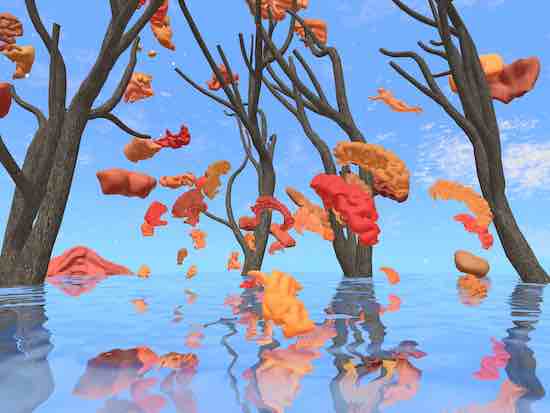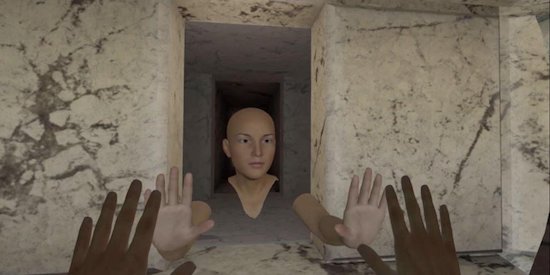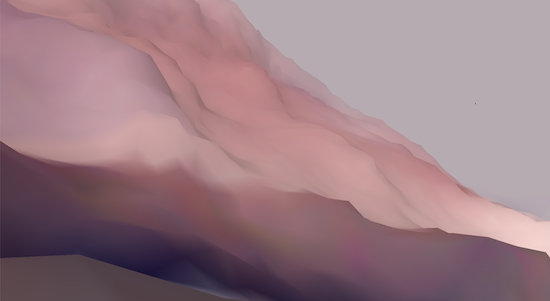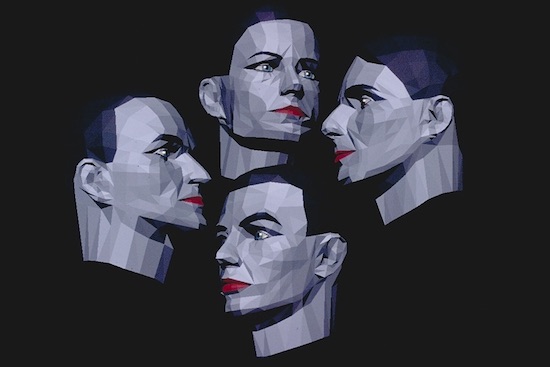Rebecca Allen, Kraftwerk Portrait (1986) Courtesy the artist.
Rebecca Allen has been making art with technology since she attended college in the early 1970s. Fascinated with the relationship between art and technological change Allen set on a path which would take her away from her art and into the world of computer technology and the emerging creative industries of that time. Now she is showing a VR work at the Zabludowicz Collection as part of their programme of virtual reality works, she looks back on how pursuing making art using computers has lead to her fascinating career.
Despite being an innovator in her field, Allen’s career has seen her focus more on technology than art but she has recently started to show work, including Life Without Matter which went on view as part of the Zabludowicz Collections’ VR programme in October. In a sense Allen’s art had to wait for the world to catch up to its ambitions.
Now, a slew of artists who have incorporated technology into their practice are extremely late adopters compared to Allen. But what made her decide to make art with computers when no one else was?
"I was studying experimental film and animation and I was also interested in some of the art movements of the industrial age, of the early 1900s,” Allen explains. “I liked the idea that they were looking at the technology of their time, looking at how their tools could be used for artistic means and how they also were affecting society.”
“This was the early 70s, so I thought computers might be – or the electronic age might be – the next step and as an artist I’d like to think about using computers to make a new kind of art form.”
She discovered she could learn more about this via a computer graphics class than in her art classes at the Rhode Island School of Design.
“I asked if I could take an independent study in computer animation and interestingly enough when I asked the art school if I could do that, they said no. Computers and artists? No."

Rebecca Allen, The Tangle of Mind and Matter (2017). Courtesy the artist.
In an effort to learn how to program Allen took classes at MIT and effectively taught herself how to code and understand what it is that programmers really do.
This was a boom time for the music industry and successful artists who were pushing boundaries sonically sought to echo that visually as music video began to take off as a medium. For those making electronic and experimental music this meant a search to find people who could make digital, experimental film.
As a creative presence in a computer lab, Allen became a point of contact for people outside the world of computer technology who were interested in accessing the latest computer technology. This included bands that, beckoning the age of the high budget music video, sought to define their image to the increasing numbers of watchers of MTV.
Allen’s first commercial project came about as Chris Blackwell of Island Records put her together with the now legendary music photographer Lynn Goldsmith, who had made what Allen calls a self help album named Dancing for Mental Health, under the moniker of Will Powers.

Rebecca Allen, Life Without Matter (2018) – Duration: 5min 30sec – Virtual Reality Art Installation. Courtesy the artist.
“I was very interested when things like MTV and the other music video channels started,” Allen explains. "Making experimental short films, I also was interested in finding an audience,” she added.
“I thought of MTV and channels like that as a way of showing short experimental films and so I agreed to make a four minute video which was an incredibly difficult things to do.”
At this stage there was no existing software, which would create the animated graphics, particularly the moving hands and faces. All this had to be built, coded, from scratch. The video for the track ‘Adventures in Success’ got a good response and the pair went on to collaborate again on the video for ‘Smile’.
“It was a nice time because it was less organised so record company people weren’t breathing down your neck,” recalls Allen. “I was in a research lab and I didn’t have to do any commercial work so I said: If you want this, I’m going to need total artistic control because I don’t know what we can do and I have to be adaptable.”
It was these videos that brought about Allen’s collaboration with Kraftwerk.
“My research was that I was trying to get human figures to move and kind of come to life and it was considered one of the hardest problems at the time. It took a while to get human movement with computer models so that was my research area that I loved,” she explained.
As an artist Allen was most interested in re-creating human movement and what was to become the band’s avatars (first featured in their ‘Musique Non Stop’ video) lead her further towards that goal.
“For Kraftwerk the rationalisation for working with them to my research lab I was working with was that I would to try and get the face to move and show expression, so we were inventing a technique to do that.”
The process took a long time and led to Allen being the “only woman to enter their studio” at the time to provide the model for the female vocal for ‘Musique Non Stop’ on their 1986 album Electric Cafe. It started with them posting her the mannequins they used on stage, which is what the lab used to map their heads and faces.
“They shipped those heads over to New York and I had to go to customs and explain it all!! It was very weird opening the box and these four heads looking up at me,” Allen recalled. “Again, there was no way to get that data into the computer so we were inventing that technique. It meant I would take little thin black tape to create a grid map on them by feeling the form of the face.”
“For the album artwork I would photograph all around the model and painstakingly, one point at a time, input that into the computer. Another super tedious technique, but the hard part is how you get the model to move, talk and blink.”
If we fast-forward to today’s art scene, new media is widespread after a long fight for a place in the mainstream, which saw this work historically showcased at tech fairs over art fairs. Now with the advent of large-scale VR projects and more exposure at institutions like The Serpentine, who exhibited Ian Cheng’s AI based work and Tate Modern’s current show with Korean digital and musical experimenter, Nam Jun Paik.
Rebecca Allen’s VR work is looking at the more spiritual side of an out-of-body experience and rather than interacting with something alien, you come face to face with yourself in the virtual landscape. All Allen’s work echoes her original aesthetic, highlighting the computing in the work rather than trying to make it seem as though it were the real world.

Rebecca Allen, The Observer (2019) – Duration: 13min 30sec continuous loop. Courtesy the artist.
Throughout her career she has used augmented, virtual and interactive technologies, often with what seems like a retro look. The thing is that when you look back, this is the look that Allen helped created in her work as an artist and as filmmaker. When speaking of technology she only has one warning: that it is run by a homogenous group and serving a heterogeneous world.
Allen’s long and fascinating journey sees her work being exhibited at the Centre Georges Pompidou, Paris, the Whitney Museum of American Art, New York and the MOMA, it also reveals her as one of a small number of digital artists who understand how to create the work that they make. As the art world enfolds digital art in a slow embrace with organisations like Daata Editions and the Ars Electronica festival, one can only hope that with a greater understanding of the technology comes more understanding and more variety in approach.
Rebecca Allen’s work is currently featured in the show You Feel Me at FACT, Liverpool, until 23 February 2020


